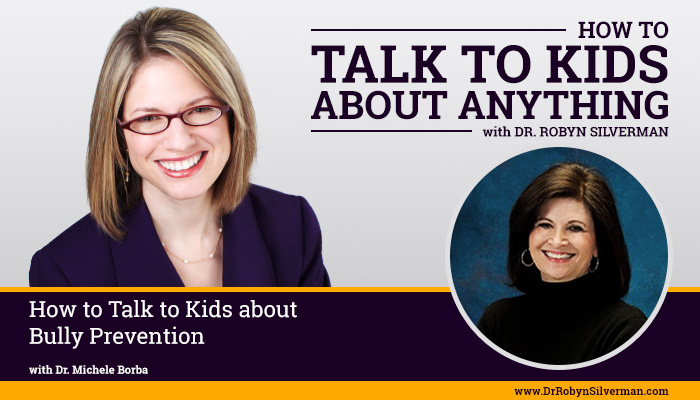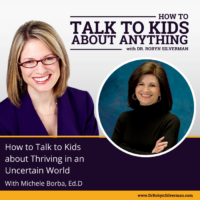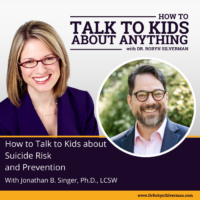Podcast: Play in new window | Download
Subscribe: Apple Podcasts | RSS | More
How to Talk To Kids About Bully Prevention
This podcast focuses on talking to kids about bully prevention. We talk about the 6 Rs of bully prevention: Rules, Recognize, Report, Respond, Refuse and Replace. Michele Borba, author of End Peer Cruelty, Build Empathy, provides tips and scripts so teachers and parents can help their kids change the cultures both in their schools and in their communities.
Special Guest: Dr. Michele Borba
More than one out of every five students report being bullied, according to the National Center for Educational Statistics (2016). 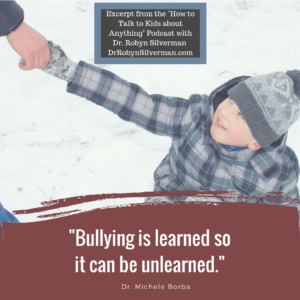 One third of students who reported being bullied at school indicate that they were bullied at least once or twice a month during the school year. The reason for this bullying? Physical appearance, race/ethnicity, gender, disability, religion, and sexual orientation, just to name the top few. There is no doubt that we have a problem and our schools, parents and children need solutions. So what do we do? And is there a way to stop bullying before it starts? We’ve talked with a few experts on social aggression in the history of How to Talk to Kids about Anything- Rosalind Wiseman, Carrie Goldman and most recently, Katie Hurley who looked at social aggression specifically in girls. Today, we are going to focus on preventative solutions to this pervasive issue- namely, what my guest and good friend, Michele Borba, is calling the 6Rs of bully prevention.
One third of students who reported being bullied at school indicate that they were bullied at least once or twice a month during the school year. The reason for this bullying? Physical appearance, race/ethnicity, gender, disability, religion, and sexual orientation, just to name the top few. There is no doubt that we have a problem and our schools, parents and children need solutions. So what do we do? And is there a way to stop bullying before it starts? We’ve talked with a few experts on social aggression in the history of How to Talk to Kids about Anything- Rosalind Wiseman, Carrie Goldman and most recently, Katie Hurley who looked at social aggression specifically in girls. Today, we are going to focus on preventative solutions to this pervasive issue- namely, what my guest and good friend, Michele Borba, is calling the 6Rs of bully prevention.
Dr. Michele Borba is an internationally recognized educational psychologist and expert in bullying, social-emotional learning, and character development and has spoken to over one million participants on five continents. She is a Today Show contributor, appearing over 140 times, and featured as an expert on Dateline, The View, Dr. Phil, and more, among others and regularly quoted in national media from New York Times, TIME, Boston Globe, Washington Post. Dr. Borba has authored 24 books; her latest are UnSelfie: Why Empathetic Kids Succeed in Our All-About Me World and End Peer Cruelty, Build Empathy: The Proven 6 Rs of Bullying Prevention that Create Inclusive, Safe and Caring Schools which comes out this week! For more information see: micheleborba.com, Facebook:Facebook.com/drmicheleborba/ and Twitter @micheleborba
The podcast provides:
- How to define bullying so we are all on the same page.
- Can bullying really be prevented? If so — what does it take?
- Why kids don’t tell adults that they’ve been bullied– and if kids don’t tell adults that they’ve been bullied, what the signs are that a child is being targeted.
- TIPS: What WE can do to help kids be less likely to become victimized
- How bullying affects bystanders and tips to help them to stand up and speak out against bullies.
- Scripts: What to say to kids to help them stand up and do something when they see someone being bullied in some way.
- How we stop the aggression of the aggressors.
- Script: What you can say to a child who is consistently being socially aggressive and intentionally mean.
Important Messages:
- Bullying is intentional, there’s a power imbalance and repeated. It’s not normal discord.
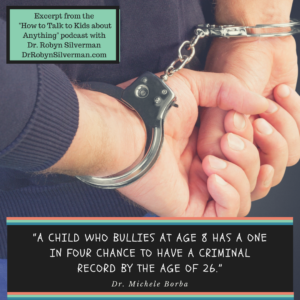
- Ask a child what s/he thinks bullying means.
- Different environments can change bullying behaviors.
- Emotional, physical, relational, cyber, verbal bullying exist. They can be reduced.
- Follow the 6Rs: Rules around it, Recognize it so people know it happens, Report it, Respond, Refuse and be assertive, helping kids replace aggression with more acceptable behavior.
- Kids don’t report because: They are embarrassed, fear of retaliation, the advice we give to kids doesn’t always work (bad advice), they don’t believe it’s as bad as it is or they don’t think there’s someone to speak to about the problem.
- Bullying is situational. It doesn’t happen everywhere in that school. It doesn’t happen everywhere in that park. Ask kids where it’s most likely to happen so you can reduce its likelihood. Look for hotspots (i.e. cafeteria, hallways, etc).
- One principal put a cut-out in each hot spot with a special note and it curbed bullying!
- Signs for bullying- behavior changes, different route to school, different friends, etc. What’s the pattern?
- Look at the color of the talker’s eyes- look more confident.
- Pull the stop sign over your eyes.
- Assert: Quick line that gets them to stop.
- Befriend the child who is being bullied- change the power dynamic.
- Chart out the power imbalance so that kids see exactly how they can change the situation.
- When kids declare that 90% kids of the kids are against bullying and want you to step in if you see it, then that’s the new norm that kids abide by.
- Want to switch the norms, reduce bullying and build empathy? Have them make signs that reflect their actual opinions and polls: For example, 90% of kids at this school are against bullying and 90% of kids at this school want you to step in if you see someone being targeted.
- Create a culture that is influences positively by the kids, get stakeholders involved, and enforce the 6 Rs.
- Big mistake- don’t label it as “kids will be kids” or “it’s a phase.” That decreases empathy and does nothing to stop bullying.
- Get under the problem- why is that person bullying?
- Kids who bully need to learn the power of empathy. Give them a service project- They begin to see themselves in a different light.
- Find out from the child who is bullying, what are they getting from it?
- Many kids are mimicking aggression from a model.
- How kids are raised makes a huge difference- model empathy, talk about it
- When children are shown how to be kind and it’s expected for them to be kind, they rise to the occasion!
Notable Quotables:
- “Bullying is learned so it can be unlearned.”
- “Bullying prevention must be systemic, sustained, ongoing and based only on proven research.”
- “In order to prevent bullying, kids must have multiple, simply options for reporting. It could be a box, text or online. They also must be able to report anonymously. When you do this, you will dramatically reduce bullying and help kids be safer.”
- When someone tries to bully you, remember C.A.L.M.: Stay Cool. Assert yourself. Look them in the eyes. And say it like you Mean it.
- “We need to teach kids to be upstanders. They’ll learn that they can switch the norm so that it’s no longer cool to be cruel, it’s cool to be kind.”
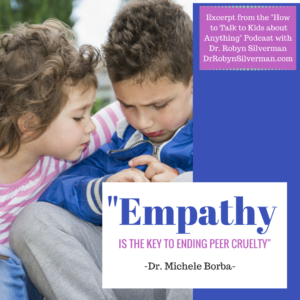 “We’ve got to help kids stop peer cruelty and give the kids the kinds of schools they deserve: safe, inclusive environments where they can learn and they can succeed.”
“We’ve got to help kids stop peer cruelty and give the kids the kinds of schools they deserve: safe, inclusive environments where they can learn and they can succeed.”- “With those kids who are bullying, we’ve got to find out THE WHY so we can figure out the strategy. It’s not a cookie-cutter approach and that’s where we are getting things wrong.”
- “For those who are bullying, that child needs a new mindset. He has to see himself as a caring human being. You act as you see yourself to be and act out based on what your need levels are. “
- “A child who bullies at age 8 has a one in four chance to have a criminal record by the age of 26.”
- “The more you engage in cruelty, the more your empathy levels go down, your conscious goes down and self control is low.”
- “We need to say to a child who has been bullying; ‘You’ve been doing this behavior, and we’re going to stop this behavior. I’m going to be there so you learn a more acceptable way to get your needs met. I’m not giving up on you! It’s you and me together. This is how we’re going to make a difference in your life.”
- “Empathy is the key to ending peer cruelty.”
- “How kids are raised makes a huge difference: Model empathy, discuss empathy and give them an opportunity to practice kindness. What you will have is YOU reinforcing the same three things that research says create empathetic children who are going to better the world.”

